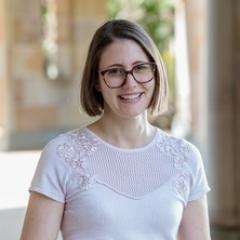Professor Justine Bell-James
TC Beirne School of Law and CBCS
I chose to study law not for any particularly clear reason – I wish I could say it was about wanting to promote justice, or even to make money – but it was just the classic “smart, bad at maths” decision. I fell into environmental law research entirely by accident. I realised very quickly I had no interest in practising law, and I was fortunate enough to find a role as a research assistant on an environmental law project. I went on to do a PhD and then found a job at UQ in 2009 teaching environmental law.
The transformational point in my career came in 2010, when I was offered a postdoctoral role at the Global Change Institute in an interdisciplinary team with fellow postdocs Megan Saunders, Javier Leon, and Morena Mills (all complete superstars now!). We worked on a sea-level rise project supervised by UQ’s who’s who of science, including Ove Hoegh-Guldberg, Cath Lovelock and Hugh Possingham. This postdoc role really confirmed that marine and coastal ecosystems are my passion – for their beauty and complexity, but also because of the really thorny legal issues that arise when you have a clash of tenures and jurisdictions. Most importantly, this postdoc immersed me in interdisciplinary research and taught me to think and approach problems in a completely new way.

Image credit: supplied.
Finding a niche
I’ve realised that a lot of interdisciplinary research happens organically as a result of forming good relationships with people from other disciplines. So many of my big projects and papers have come from a casual chat with a scientist about their ideas. For example, maybe eight years ago now Cath Lovelock told me about a burgeoning idea to remove bund walls from farms to allow tidal reinstatement. This immediately made me think about the legal questions – what does this mean for property boundaries, and what happens if the flooding occurs outside of the expected boundaries? These were questions that I got to unpack in the development of the first blue carbon method, which became law in 2022 – a turning point for coastal restoration in Australia. Another example is a piece I recently published in Nature Ecology and Evolution with James Watson. This came about from a chat over coffee at Old Parliament House in Canberra (between debating the proposed reforms to the Environment Protection and Biodiversity Conservation Act 1999).
Working this way has also allowed me to carve out a really unique research area and establish myself as the leading expert – something that I think is really challenging to do in your disciplinary silo! Some highlights of my career have been going to COP21 in Paris and attending the launch of the International Partnership on Blue Carbon (I also got to meet Sir David Attenborough!), and, of course, the many workshops on Heron Island that you get to attend working in the marine and coastal space.

Image credit: supplied.
My vocation
These days I am a Professor in the TC Beirne School of Law at UQ. I still teach environmental law to final-year students but I am also really lucky to now be teaching foundations of law to first years and using this to embed climate change and biodiversity content into our core curriculum (alongside really critical work underway to Indigenise our curriculum). I am working on (probably way too many!) excellent projects and papers on marine and coastal restoration, and biodiversity law reform in Australia. I’m really excited to have joined the Wentworth Group this year. I am also the Director of UQ’s Climate Change Research Network, a major initiative that kicks off this year as an “umbrella” to sit across the huge depth and breadth of work underway across UQ (including CBCS). I am really happy about using this opportunity to design initiatives to hopefully give the next generation of researchers the same formative immersion in interdisciplinary research that I was so fortunate to have.
To keep up to date on our latest events, check out our Bluesky and LinkedIn.

